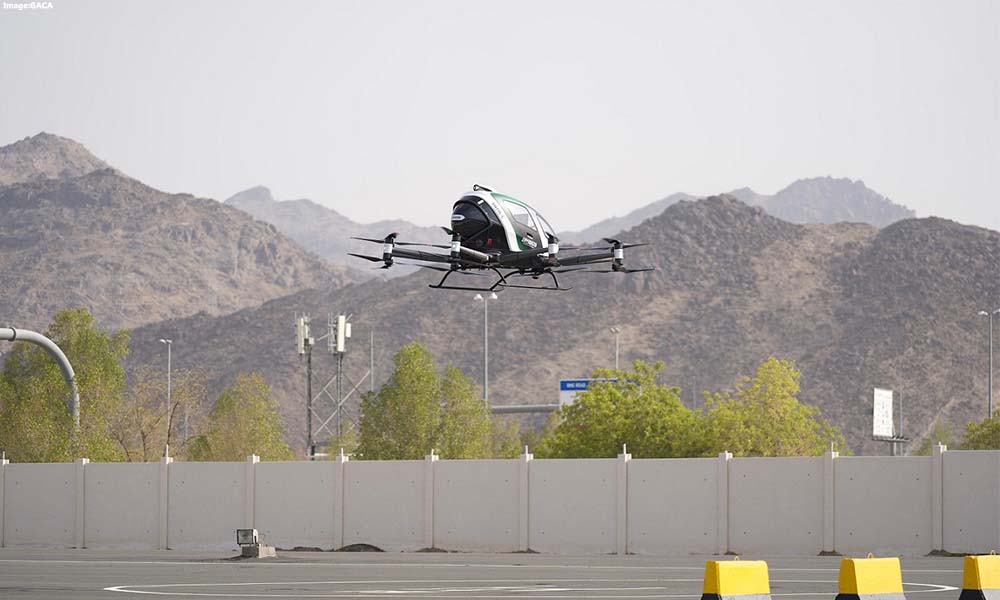Aviation
Saudi Arabia Unveils First Self-Driving Air Taxi for Hajj Pilgrims

In a groundbreaking move, Saudi Arabia has initiated trials of self-driving air taxis during the Hajj of 2024, marking it as the first nation to offer a civil aviation authority-approved service of this kind.
This innovative transportation solution is designed to enhance the travel experience for pilgrims journeying between Makkah and Madinah, today hajj flight time ensuring efficient and timely transportation, especially in emergency situations.
United Airlines Threatens Deplaning After Business Class Passengers Decline to Swap Seats with Crew
The Transport General Authority has rolled out these electric air taxis to facilitate not only the transportation of pilgrims but also to provide logistics services for urgent medical transfers and supplies. This initiative is in line with the goals of Saudi Vision 2030, which aims to promote sustainable and AI-driven transportation solutions throughout the Kingdom.
Saleh bin Nasser Al-Jasser, the Saudi Minister of Transport and Logistic Services, proudly announced that this initiative represents the world’s first civil aviation authority-licensed flying taxi service. He, along with Abdulaziz Al-Duailej, president of the General Authority of Civil Aviation (GACA), and Rumaih Al-Rumaih, Deputy Minister of Transport and Logistics Services, attended the launch event, where they witnessed the vertical takeoff of this autonomous vehicle.
Qatar Airways bans these new Electronic Devices on plane
“The inauguration of the air taxi is part of our efforts to adopt future transport technologies and environmentally friendly models utilizing artificial intelligence,” Al-Jasser stated. He emphasized that this initiative aligns with the National Transport and Logistics Strategy, which seeks to modernize Saudi Arabia’s transport sector through the deployment of air taxi technologies, electric vehicles, and hydrogen trains.
The air taxi will play a crucial role in facilitating transportation across the holy sites, enabling quick transfers for medical emergencies and delivering goods efficiently. This innovative approach aims to enhance the overall Hajj experience, making it more convenient and streamlined for pilgrims.
As part of the broader initiative, the air taxi experience is one of 32 modern technologies being implemented to assist pilgrims during this year’s haj committee of india flight date and time . The plan includes 50 confirmed aircraft with an option for an additional 50, with the first deliveries scheduled for the fourth quarter of 2026. The air taxis will create new air routes to Makkah, making travel easier for pilgrims during the Hajj and Umrah seasons.

Aviation
COMAC Unveils Plans for the C929 to Rival Airbus and Boeing

After the success of China’s first C919 aircraft, the country is setting its sights on developing a larger plane. COMAC (Commercial Aircraft Corporation of China) has officially confirmed plans to build a widebody aircraft, marking a significant step in its aircraft lineup.
Traditionally, Airbus and Boeing dominate the widebody aircraft market, with decades of expertise in developing planes and engines capable of carrying heavy payloads. China, which currently relies on imported engines, is now aiming to challenge these giants with its own widebody jet, the C929, designed to compete with the Airbus A350 and Boeing 777.
American Airlines Is Looking for Flight Attendants: Apply Now
The C929 will be China’s first independently developed long-range widebody aircraft. It adheres to international airworthiness standards and boasts independent intellectual property rights. The baseline version is designed to seat 280 passengers and offers a range of 12,000 kilometers, catering to global demand for both regional and international air travel.
Russia, which also needs reliable narrowbody and widebody aircraft, could become a key customer for the C929. Additionally, China plans to target the broader Asian market as it continues to expand its aviation capabilities.
Close Call at Heathrow: BA Flight Narrowly Escapes Drone Collision
China’s aviation progress includes the ARJ21 (now called C909), a regional jet with 100 seats for shorter routes, and the C919, a narrowbody jet with 180 seats designed to rival the Boeing 737 MAX and Airbus A320. Both models have found increasing demand in the domestic market.
At China’s largest air show in Zhuhai, COMAC announced that Air China will be the launch customer for the C929 widebody jet, though details about order size and delivery timelines were not disclosed.
Other major deals announced by COMAC include:
- Hainan Airlines: Firm orders for 60 C919 and 40 C909 regional jets.
- Colorful Guizhou Airlines: 30 C909 jets, with 20 firm orders and 10 provisional agreements.
The C929, renamed from the CR929 after Russia withdrew from the joint development project in 2023, is expected to carry 280–400 passengers with a range of 12,000 kilometers, competing directly with Boeing’s 787 Dreamliner.
According to COMAC’s deputy general manager, Tong Yu, the first fuselage section of the C929 is expected by September 2027, with prototype test flights anticipated soon after.
-

 Aviation2 months ago
Aviation2 months agoMicrosoft Flight Simulator Raises $3 Million to Bring Back the An-225 Mriya
-

 Airlines2 months ago
Airlines2 months agoQantas Engineers Stage Walkout Over Cost of Living Concerns
-

 Airlines2 months ago
Airlines2 months agoQatar Citizens Can Travel to the United States Without a Visa
-

 Aviation2 months ago
Aviation2 months agoQatar Airways bans these new Electronic Devices on plane
-

 Airlines2 months ago
Airlines2 months agoJapan Airlines Rolls Out Free Domestic Flights to International Passengers
-

 Defence2 months ago
Defence2 months agoWhich Country Has the Largest Fleet of Fighter Aircraft?
-

 Airport2 months ago
Airport2 months agoWestern Sydney Airport Welcomes Its First Plane After 6 Years of construction
-

 Aviation2 months ago
Aviation2 months agoDid you know ? Once Boeing 747 carried 1088 passenger in 1991








